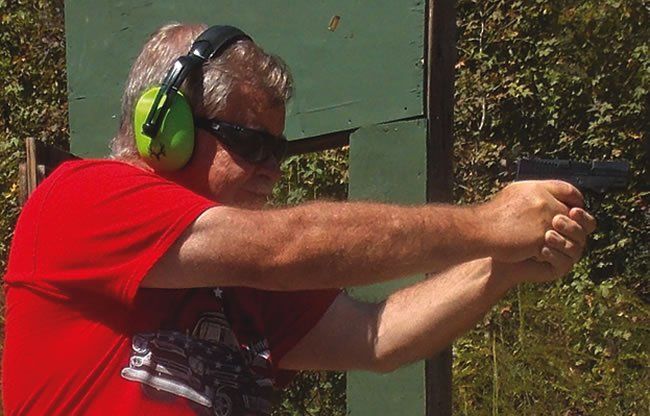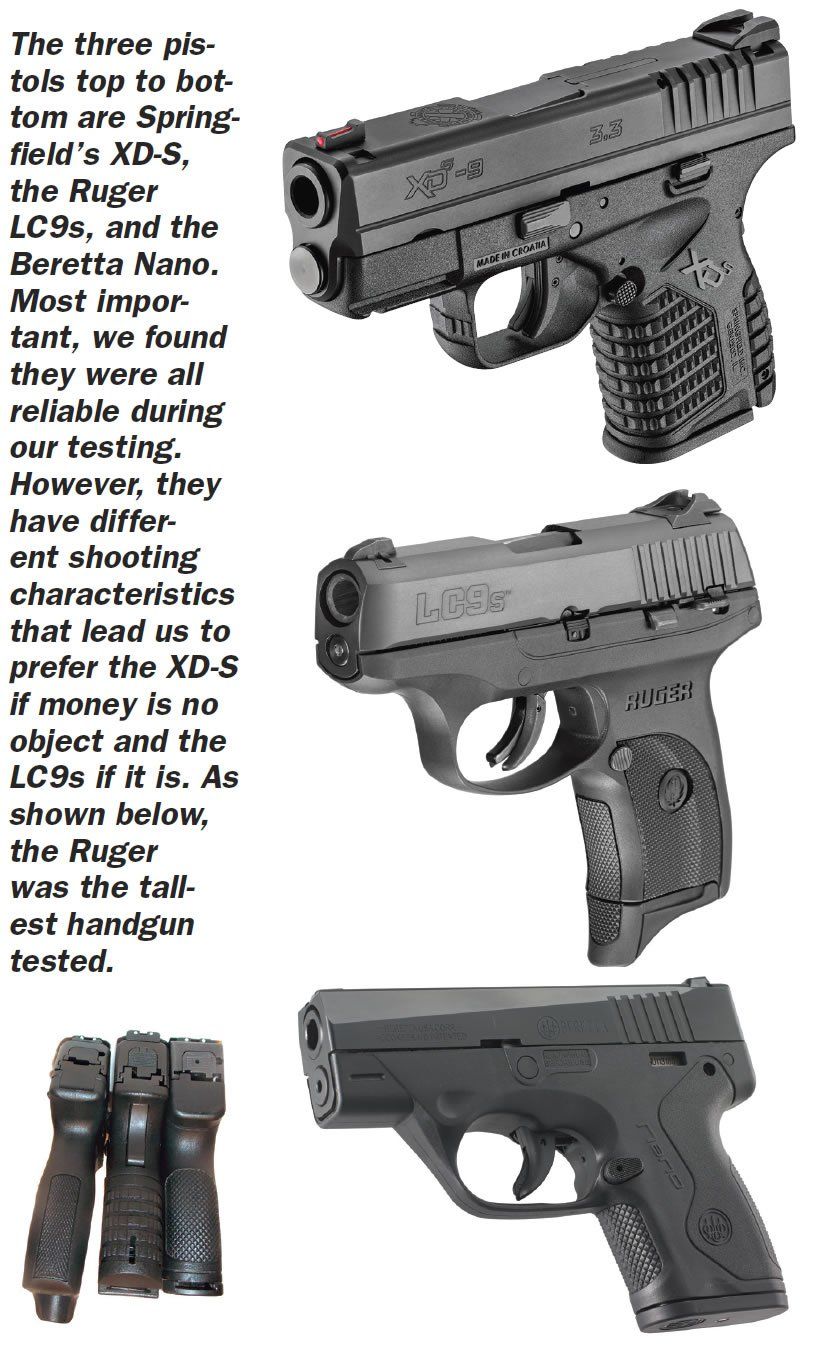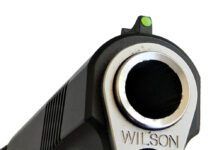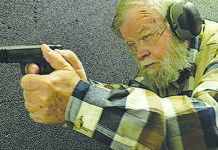Subcompact 9mm handguns are very popular carry guns, and in the past we have tested various 9mm compacts that are basically scaled-down service pistols, such as the Glock 26 and the Smith & Wesson Military & Police Compact. In contrast, the handguns covered in this report are 9mm subcompacts designed from inception as compact carry guns. Our test guns chambered in 9mm Luger were the Beretta BU9 Nano JMN9S15 9mm Luger, $369; the Ruger LC9s Standard 3235 9mm Luger, $339; and the Springfield Armory XD-S 3.3 XDS9339B, $494.

Our Beretta BU9 Nano JMN9S15 had an MSRP of $445, but we got ours at CheaperThanDirt.com for $369. At that MSRP, our black Nano, a pink version (JMN9S65), and a Flat Dark Earth-colored one (JMN9S55) are the least expensive pistols in the line, which includes state “compliant” models (JMN9S15FC, JMN9S65FC, JMN9S55FC) in the same colors, respectively, for $452. More expensive versions come with Crimson Trace lasers for MSRPs that start at $650.
Ruger’s recently announced LC9s Pro (Model Number: 3248) has no external manual safety or magazine disconnect, making the original LC9s tested here the “Standard” model. Both have MSRPs of $449, but the price above reflects what Cheaper Than Dirt! was selling the gun for at the time of our test.

The XD-S pistols are the first single-stack polymer-framed versions from Springfield Armory. Our basic black XD-S 3.3 externally resembles the XD-S 45, which we tested in the December 2012 issue (Grade A). There’s also a 9mm Bi-Tone 3.3-inch gun (XDS9339S) as well as 4-inch-barrel XD-S models.
When firing for accuracy at 15 yards, we used two loads from HPR, 115-grain jacketed hollowpoints ($28.13 for 50 rounds at CheaperThanDirt.com) and the HPR 124-grain XTP (also CheaperThanDirt.com, $26.65 for 50 rounds). We also used Black Hills TAC +P, which uses a Barnes 115-grain Tac-XP hollowpoint bullet, available from MidwayUSA.com for $25.20/50. We also handled the guns in more realistic tactical situations to assess their suitability for carry. Here’s what we found:
Beretta BU9 Nano JMN9S15 9mm Luger, $369
Beretta broke new ground with the striker-fired Nano. The company calls it a single action, but its function is similar to the Glock, which we think of as a double action, and in the end performs in a similar manner. The striker safety protrudes from the top of the slide just in front of the rear sight as the trigger is pressed and the safety is released. There is also a decocker button to release the prepped striker. It requires a pin be pressed into the button, at the top rear of the grip frame. This eliminates the need to press the trigger to decock prior to disassembly. These are good features, and the Nano seems to be a well-thought-out pistol for concealed carry. It trades less weight, less bulk, and less barrel length for smaller sights, less capacity, and fewer features.
As an example, the Beretta does not have a slide lock in the conventional sense. The slide locks open as the last cartridge is ejected. The magazine is removed and the slide remains locked, and it is grasped at the rear to release. Speed loads are best accomplished by grasping the rear of the slide and releasing the slide on a fresh magazine. When firing service loads, it is common for the thumb of the support hand to bump into the slide lock in very small handguns, and we saw this happen often enough that we realized how the absence of a slide lock may improve combat reliability. One-hand operation would be another matter.
At 7.5 pounds, the trigger action was heavier than we like. While smooth enough, this heavy activation weight bore on the muscles during a range session. We are certain accuracy was affected by this trigger action, along with the small sights and grips. Only two fingers may be placed on the grip when the six-shot magazine is loaded. With the eight-round magazine in place, the grip is much more comfortable. Still, for the pocket, the six-round magazine is better. In IWB carry we believe the eight round magazine would be as concealable as the shorter unit.

The sights were the subject of some debate. They were almost as small as the bumps that are called sights on 32 ACP and 380 ACP pocket pistols. They were white-outline three-dot units set atop a square-top slide, which we thought affected visibility. For example, on the Ruger, the slide tapers to the top, and the taller Ruger sights accordingly draw the eye. Also, the Nano’s sights were smaller than the Ruger or Springfield sights.
Despite the Nano’s light weight — right at 20 ounces unloaded — it was comfortable to fire, according to our shooters. We fired several 9mm loads, including the Black Hills 115-grain FMJ load (MidwayUSA.com, $9.18/20 rounds) during the familiarization stage of the test.
Even when firing the hotter Black Hills 115-grain TAC +P, we still thought the Nano was comfortable to fire. We also fired a small quantity of the Cor-Bon 95-grain DPX (Corbon.com, $33.63/20) load. We did not have enough for a thorough test, but this seemed to be a good short-barrel load and with it, the Nano remained comfortable to fire.
In combat drills at 5, 7, and 10 yards, our shooters found the pistol drew quickly from the Barber Leatherworks Chameleon holster used during the evaluation. Our shooters said that while firing the 115-grain FMJ load off hand, the Nano demanded concentration. We did not have to adjust our hand position after a string, and we thought the modest stippling on the grip was adequate for control. However, the Nano was the least controllable of the three pistols in rapid fire. Hits on the steel plates were more difficult, and combat groups were not as tight as the other pistols. One rater felt that he had to work to reacquire the sight picture after every shot. The level of accuracy was not up to the level demonstrated by the other handguns. Our shooters tried their best and simply could not speed up and get hits. In our view, the sights are less than ideal and so is the trigger.
When we shot five-round groups for accuracy, the pistol tended to put two shots in one group and two to three in another, evenly spaced. We think this had much to do with the shooter attempting to control the trigger, the small sights, and short sight radius. The average group with the Black Hills load was 3.25 inches, while the largest average group was 3.6 inches with the HPR 124-grain JHPs. Bullets fired from the Nano averaged slightly greater velocity than the Ruger. As an example, the Black Hills 115-grain TAC load averaged 1052 fps from the Nano versus 1020 fps from the Ruger.
Disassembly is accomplished by turning a screw located on the right side of the frame about a quarter turn. There is no takedown lever. It looks cheap, but it works. The screw did not become loose during firing tests.
Our Team Said: The Nano never failed to function. It was the shortest handgun tested, so if pocket carry is important, this is the most concealable handgun, in our estimation. In the end, though, we rated the pistol down for its small sights, heavy trigger, and worst of group accuracy.
The LC9s is a striker-fired variant of the LC9. That is saying a lot in a few words. The pistol has undergone a major redesign. The hammer is contained in the frame in the LC9; the striker is all in the slide in the LC9s. The trigger mechanism and firing-pin block are also different. The trigger incorporates a lever in the trigger face to prevent the pistol from firing unless the trigger is pressed to the rear by the trigger finger.
Trigger compression was the strong point of this handgun. The trigger broke at 5.25 pounds and it was clean, with a slight take-up and a fast reset. Combat accuracy was superior to the Nano, but not on par with the Springfield. That was probably as much a function of the trigger as the sights. The sights were good, noticeably better than the Nanos, in our estimation.
The Ruger was the only pistol tested that features a manual safety. This was more important to some shooters than others. The thumb safety was unobtrusive, positive in operation, and may be activated easily. It featured good indent, so it will not slip off easily. It fell under the thumb when taking a natural firing grip. The Rugers takedown, accomplished by pulling a bar on the left side of the frame, was simple enough to do.
On the downside, the Ruger developed the least energy and velocity of the three pistols. The Black Hills TAC +P load delivered 1020 fps, a full 80 fps less than the 3.3-inch-barrel Springfield. The 30-fps advantage of the Nano with this load wasnt significant in our view, but 80 fps is.
Conversely, the Ruger seemed to exhibit the greatest felt recoil of any of the handguns tested. Not uncomfortable or startling, but greater than the other 9mm handguns. The pistol was thin, which we liked, but the grip frame was the longest of the pistols tested, making the Ruger LC9s the tallest handgun of the three test pistols.
In benchrest testing, the Ruger demonstrated acceptable accuracy, with the best average group coming with the Black Hills TAC +P load at 2.8 inches. Accuracy was better than the Nano by a margin, but it was not as good as the Springfields average.
Our Team Said: When comparing prices of the handguns we liked the best, the Rugers $339 price seems attractive compared to the Springfields $494. However, the Ruger doesnt have the plastic holster and magazine carrier of the Springfield, but then holsters are personal and you will wish to get a good concealment holster anyway. The major gripe with the Ruger is that it is supplied with only one magazine. The average price of a Ruger LC9 magazine is about $30, so this brings the Ruger up to $370, on par with the Nano and still much less than the Springfield. Given its performance, we think the Ruger is the best buy for the money.
The Springfield XD-S is a highly modified XD that stands on its own merits. It resembles the larger XD pistols, but the operation is different. The XD-S is more like a service pistol than the other handguns tested, in our opinion. It is also the longest – but not the tallest, thats the Ruger – and the easiest to use well.

The pistol featured a dust cover on the rear of the slide rather than the characteristic exposed striker of the larger XD. The stippling and surface abrasion of the Springfield were ideal for our shooters. The finish was never uncomfortable, and the grip was never in question. The XD was also the only handgun with an ambidextrous magazine release. Takedown was via a lever, a feature on larger service-grade handguns.
The low profile sights featured a red fiber-optic front component and a drift-adjustable steel rear sight. This made for good results when running a combat course at high speed. We began the combat course with the Black Hills 115-grain FMJ load, progressed to the HPR 115- and 124-grain loads, and fired a single magazine of the Cor-Bon DPX load. Results were excellent. We were able to keep the steel plates ringing and combat groups were excellent, but then this was the heaviest handgun and the one with the longest barrel. During this time at the range, we thought the trigger compression was suitably controllable, but not as good as the Rugers. At 7.0 pounds the XD-S didnt have a light trigger, but we had greater confidence in this trigger than the Nanos.

Early on, we experienced a failure of the slide to lock back on the last round after every magazine and with both magazines. After the first four magazines of ammunition, the slide began to lock back. This may have been shooter error, as we may have rode the thumb on the slide lock. Also, on several occasions, we felt that too much effort was needed to operate the magazine release. Again, this cleared up during the test. Perhaps we simply needed to learn the touch. In any case, the slide never locked back during a firing string, so we were not applying upward pressure during recoil – a neat bridge on the frame prevents this from happening. Each handgun must be learned for its own merits and foibles.

Once the magazine-release problem was solved, the pistol exhibited excellent speed in magazine replacement. We fired with both the 7-round and the optional 9-round magazine. There wasnt a lot of difference. If maximum concealment is needed, the shorter magazine works well, while the longer magazine gives 10 rounds at the ready when concealment isnt as important.
When firing for accuracy off a bench rest, the Springfield put out the best averages across the board, most notably 2.0 inches with the HPR 115-grain JHP loading. The XD-S also demonstrated the greatest energy, 308 foot-pounds compared to 265 foot-pounds for the Ruger and 282 foot-pounds for the NANO when using the Black Hills Ammunition 115-grain TAC +P.
Our Team Said: The XD-S is supplied with a range holster, magazine carrier, and a spare magazine. The Springfield also had a rail, a loaded-chamber indicator on the top of the slide, and grip inserts. If you are willing to spend the extra money and carry the pistol in an inside-the-waistband holster rather than the pocket, the XD-S represents a good option. The Springfield, in the words of one rater, Shoots like a big gun. The Ruger may represent the better value, but we preferred the Springfield XD-S.
Written and photographed by Bob Campbell,
using evaluations from Gun Tests team testers. GT
9MM_LUGER_SUBCOMPACT_RANGE_DATA.pdf
BERETTA_BU9_NANO_JMN9S15_9MM_LUGER_369.pdf





























